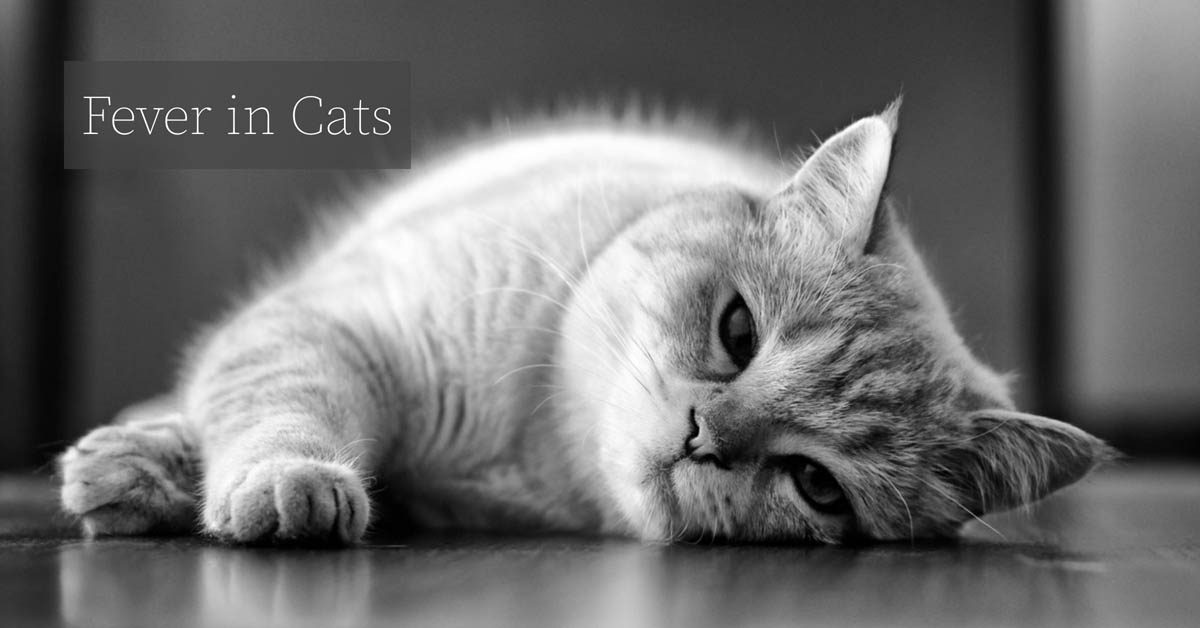At a glance
|
What is a fever?
Also known as pyrexia a fever is an elevation in body temperature which is generated by the body to fight disease. Normal body temperatures in cats range between 100 – 102.5°F (37.7 – 39.1°C).
There are two causes of an increase in body temperature, fever or hyperthermia (one cause of hyperthermia is heat stroke).
The hypothalamus located in the brain regulates temperature and acts as a thermostat in the body. Fever occurs when the body senses the presence in the blood of small molecules known as pyrogens (fever-producing substances). These usually come from a source outside the body and in turn, stimulate the production of pyrogens inside the body. Pyrogens tell the hypothalamus to increase the temperature setpoint, resulting in a fever.
Causes
- Bacterial infection: Foreign body, pneumonia (infection of the lung sacs), pyothorax (pus in the pleural space in the chest), pyometra (infection of the uterus), bite wound abscess, mycoplasma hemofelis, peritonitis (inflammation of the tissue covering the abdominal organs and abdominal walls), endocarditis (infection of the inner lining of the hear).
- Protozoa: Toxoplasmosis.
- Systemic fungal disease: Aspergillosis, cryptococcosis, blastomycosis.
- Viral: FIP, FIV, FeLV, feline herpes, coronavirus, panleukopenia.
- Inflammation: Pancreatitis, cholangiohepatitis, myocarditis (heart inflammation).
- Immune-mediated inflammatory disorders: Systemic lupus erythematosus, pemphigus, hemolytic anemia, idiopathic thrombocytopenia.
- Cancer.
- Some drugs (drug fever): Interferons, certain antibiotics, antihistamines.
- Endocrine disorders: Hypoparathyroidism.
- Idiopathic (unknown cause): This is known as fever of unknown origin (FUO).
Fever serves a useful purpose in attempting to combat any infections by creating a hostile environment for the pathogen, which makes it harder for them to take hold and reproduce within the host body. High temperatures also help the immune system to function more effectively. Unfortunately, fevers, particularly high fevers have a detrimental effect, especially if they are prolonged, this includes possible brain damage.
Symptoms
Symptoms can vary depending on the underlying cause, but may include:
- Lethargy
- Dehydration
- Loss of appetite
- Pain and tenderness when touched (hyperalgesia)
- Shivering
- Ears that are warm to the touch
- Hunched over appearance
- Panting
Other symptoms may be present depending on the underlying cause. For example, if the cat has ingested poison he may be vomiting, a cat with cat flu will sneeze and have nasal discharge.
How can I tell if my cat has a fever?
The only way to accurately tell if your cat has a fever is to take his temperature. We recommend two people so that one person can hold the cat while the other takes the temperature.
To do this, shake down the column of mercury until it reads 96°F (36.1°C), then lubricate the bulb tip with petroleum jelly. Grasp the base of your cat’s tail and lift it. Insert the lubricated end of the thermometer about halfway into your cat’s rectum and hold it in place for 3 minutes. Remove the thermometer, wipe it clean with a tissue and read the silver column of mercury.
Diagnosis
The veterinarian will perform a complete physical examination of the cat and obtain a medical history, which will include questions on any exposure to toxins or drugs, other symptoms you may have noticed, how long has your cat been running a fever? Your cat will perform a complete physical examination, carefully checking for signs of infection, inflammation, injury, abscess, lumps, and bumps. The most common cause of fever in cats is due to infection.
The age of your cat may give a clue. Young cats are more likely to have a fever due to infection, while older cats may be due to cancers. Outdoor cats, especially males are prone to bite wound abscesses.
Diagnostic workup:
- Biochemical profile: To evaluate organ function and check electrolyte and hydration levels.
- Packed cell volume and total protein: To measure the level of anemia or dehydration. It measures the percentage of red blood cells found in whole blood
- Complete blood count: To evaluate for signs of infection. Cats with an infection often have an elevated white blood cell count.
- Cytology: Microscopic examination of effusions, blood, cerebrospinal fluid and urine.
- Blood smear – To check for blood parasites.
- Urinalysis: To check kidney function and for infection. A urine culture may also be performed to check for bacteria in the urine, which would indicate a urinary tract infection.
- Ultrasound or x-rays: To look for tumours, pneumonia, and abscesses.
- Biopsy: If tumours are found a biopsy will be taken for microscopic evaluation.
- Electrocardiogram (ECG): A non-invasive test that uses high-frequency sound waves to capture live images of the heart to examine the anatomy and function of the heart and valves.
Treatment
The goal of treatment is to manage the underlying cause as well as supportive care.
NEVER administer over the counter painkillers such as Ibuprofen (Advil/Nurofen), Paracetamol (acetaminophen) or Aspirin to reduce a fever in cats as these medications are extremely toxic to cats.
Generally, temperatures < 105°F (40.5°C) should be monitored closely if the temperature rises above 105°F then veterinary attention needs to be sought immediately.
Supportive care:
- Fluids to treat dehydration, nutritional support, antipyretics if the fever exceeds 41C (106F). Fans can help cool the cat and bring the temperature down.
Treat the underlying cause:
- Antibiotics for bacterial infection. The veterinarian may recommend culture and sensitivity to determine the most suitable antibiotic.
- Surgery and/or chemotherapy for malignant tumours.
- Glucorcoids or immunosuppressive drugs for immune or inflammatory causes.
- Analgesics, anti-nausea medication, and supportive care to treat pancreatitis.
- Cease medications (if possible) or change medications to treat drug-induced fever.
- Anti-fungal medications for fungal diseases.
- Calcium and vitamin D for cats with hypoparathyroidism.
- Medications to correct heart rhythm abnormalities.
- Address the cause of hemolytic anemia and in some cases blood transfusion.
- Blood transfusions for severe cases of hemolytic anemia or systemic lupus erythematosus.

